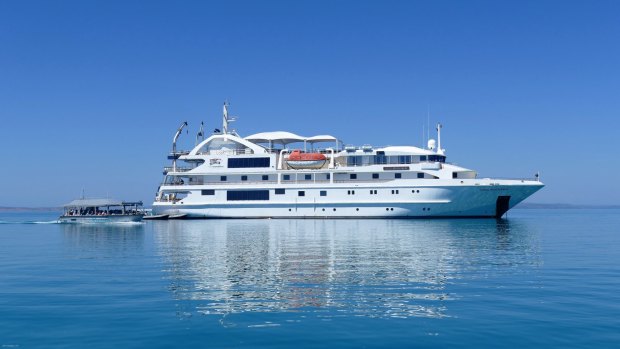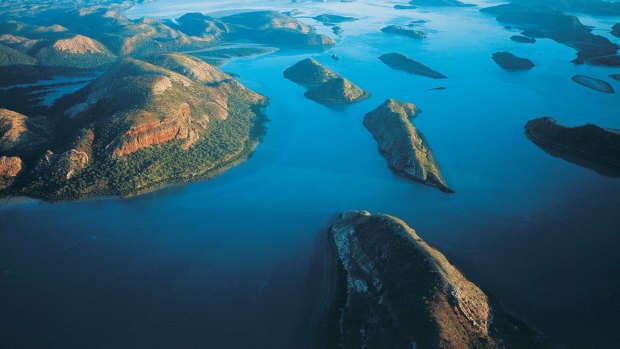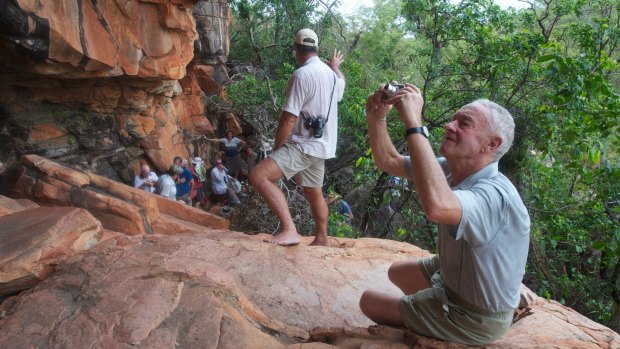This was published 5 years ago
Cruising the Kimberley, WA: The best and almost only way to visit this part of Western Australia

The Coral Expeditions Kimberley cruise in Western Australia.
I've never thought much about tides before. They come in, they go out with a regularity that accords me genteel walks along squishy suburban sand. Not in the Kimberley, though. Here, tides can rush in at three metres an hour and fall so dramatically that waterfalls are created mid-ocean. Here, tides are among the biggest and most brutal in the world, alternatively creating and submerging islands, and battering the coastline's endlessly convoluted bays.
Cruising the Kimberley coast between Broome and Darwin will leave me astonished, but its tides are a particular amazement from the moment I think I've missed the boat. Coral Discoverer sits at low tide in Broome and has vanished behind a wharf high as a multistorey building. It's the first time I've had to clamber downwards to board a cruise ship. The shadowy underbelly of the wharf is encrusted with clams and seaweed.
"Every cruise itinerary differs," says expedition leader Michael as he briefs passengers later that evening. "We have to consider sea conditions, wind and tides daily. Maybe we can get into a bay, but can we sail out again later? What's the sailing time if we're pushing against an incoming tide? And what's the best moment to see what we all want to see?

Spectacular Talbot Bay in the Kimberley.Credit: Alamy
"The things I want to see come later, but things I've never even heard of thrill me, too. Next day has us in the Lacapede Islands, a precarious set of sand-topped, grass-tufted coral outcrops lying off the Dampier Peninsula. As we sail towards them, hundreds of birds swirl in the sky like black snow: crested terns with the grace of aerial ballerinas, silver gulls, forked-tailed frigate birds that dive-bomb like Stukas to snatch other birds' fish.
We transfer into Zodiacs and nudge close to shore. The Lacapedes boast the world's largest colony of breeding brown boobies, and Australia's largest colony of lesser frigate birds. They cohabit with dozens of types of wading birds and pelicans. Sting rays, baby sharks and gulping green turtles float in the water.
"You're here at a good time at the tail-end of the wet season, just before the trade winds start," says Michael. "There are enormous tides here, the second largest in the world, and the islands are sometimes exposed to three-metre swells. We only got here twice last year, so we're lucky today."

Exploring during a Coral Expeditions cruise.
Timing is key in a landscape that always reminds you that nature is in charge. Next morning, we're sailing to see the Horizontal Falls in Talbot Bay, where huge tides surge through a narrow gap in the escarpment and fill up an embayment (flooded valley) behind. The tide rises so quickly it can't push through the gap, creating a difference in water level of up to five metres.
Our Zodiac excursions must be timed for when water levels and whirlpools aren't as extreme. Still, it's a wild ride. We cling to ropes on the Zodiac's side as we lurch through churning water, engine roaring and spray flying. It's another astounding experience.
Even without the Horizontal Falls, Talbot Bay is superb. From the deck of Coral Discoverer, I'm surrounded by a ring of red cliffs darkened in places with seams of iron ore. Mangroves ankle-deep in mud will later be almost drowned. Tawny nurse sharks circle off the ship's stern.
Later we sneak up Cyclone Creek in the purpose-built tender Xplorer, which has an almost-flat hull and can carry all the ship's passengers into shallow waters. The creek is more a canyon whose orange rocks are buckled and bent, in places uplifted into vertical slabs.
As we sail away that evening, the rocks are so red they reflect onto the ship's white superstructure so it glows pink as a shell. Sunsets, reddened by the smoke of early dry-season burn-offs, are a daily magnificence best enjoyed from the ship's open-air Explorer's Bar, cold beer in hand to counteract the heat.
Next morning, expedition staff member Dave provides a useful lecture on the day's destination, Montgomery Reef. It's Australia's largest inshore reef, 80 kilometres long, with more than a hundred species of both hard and soft corals creating a fringing lagoon around a sunken sandstone mesa. As the tide falls, seawater is trapped inside the lagoon but gushes down its now-exposed sides in a series of waterfalls which, on low tides, can be four metres high.
We anchor just outside the reef and enter on Xplorer through a three-kilometre crack in its wall. Abundant bird life is attracted by a smorgasbord of sea creatures left behind on the exposed coral. Crabs scuttle. Turtles, which normally stay underwater for an hour at a time, are battling such huge tides that they must keep surfacing for breath.
"The weirdest creature is the epaulette shark, which can walk on its fins from pool to pool," says Dave. "We're still finding new species here, and we don't even know much about the reef system. As far as I know, it's the only place in the world where waterfalls form, seemingly in mid-ocean."
We sail on, using all three of our Coral Expedition vessels – ship, Xplorer and Zodiacs – to explore this two-billion-year-old coast, one of the earth's oldest landscapes. At the end of Red Cone Creek, the canyon is barely wide enough to fit our Zodiac, and we clamber up the side of Ruby Falls to wallow in a waterhole away from the domain of saltwater crocodiles.
Next morning the sun rises in an explosion of red above Hanover Bay as the water shimmers orange. One evening we're ferried onto Winyalkan Beach on Mudge Bay for cocktails, canapes and a virulent red sunset. The beach is littered with pink and purple shells many metres deep and a million years in the making.
On another day, we explore the Prince Regent River, whose riverbanks of cubic red sandstone look like the ruins of some fabulous ancient city: temples and ziggurats topped with eucalyptus trees and flanked by mangroves. King Cascade seems almost landscaped, attractively tiered and framed in delicate ferns. If it weren't so very far away this coast would be famous. There are no roads, and you can only explore by seaplane or cruise ship. Sometimes you feel you're looking at things few people have ever seen.
It's all astonishing, but the sunburnt Kimberley might just have saved the best for last. On our final morning, we head up the King George River, framed in cathedral cliffs of red rock that dwarf Xplorer. The canyon is grand and fierce and unimaginably old, crowned off by the twin King George Falls, 80 metres high – at least when the tide is low.
Brian Johnston travelled as a guest of Coral Expeditions.
TRIP NOTES
MORE
FLY
Qantas flies direct to Broome and Darwin from Sydney and Melbourne. Phone 13 13 13, see qantas.com
CRUISE
Coral Expeditions operates 10-day Kimberley cruises between Broome and Darwin (or the reverse) on Coral Discoverer and Coral Expeditions. In 2019, new ship Coral Adventurer joins the fleet. Fares from $8290 a person twin share, including all meals, mealtime beverages and shore excursions. Phone 1800 079 545. See coralexpeditions.com
Sign up for the Traveller Deals newsletter
Get exclusive travel deals delivered straight to your inbox. Sign up now.